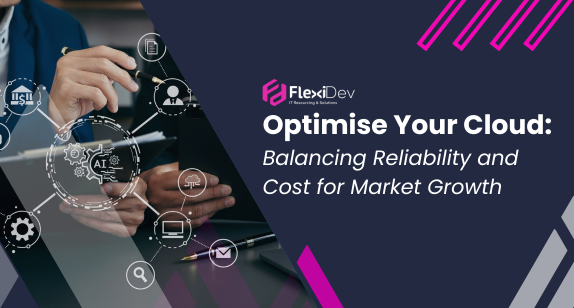
by Niki Akbar – Senior DevOps Engineer
Enhance Your Online Presence By Strategically Balancing Cloud Infrastructure Reliability And Cost: Finding That Sweet Spot For Market Growth
Cloud infrastructure has become a dominant force in the provision of highly accessible and resilient online services. Essentially, getting the right fit for your product service today hinges on finding a balance between reliability and cost-effectiveness. And what you need for long-term sustainability is a clear understanding of which package opportunities closely align with your current needs and projections for future expansion, as well as how they will realistically behave when implemented. From web hosting to complex hybrid application systems managing the storage of massive data sets, we aim to empower our clients to better facilitate seamless and financially worthwhile cloud infrastructure provision. Let’s just outline the critical factors FlexiDev advises its clients to prioritise to ensure scalability, flexibility, and to maximise gain.
Do not sacrifice service quality
Reliability is paramount in the world of cloud computing, especially during peak demand. High responsiveness during uptime, or happy-users-on-your-product time, equates directly to a healthy revenue stream, safeguarding of brand reputation, and higher user productivity. Likewise, enterprises that wish to place their product within a top-tier performance bracket must keep in mind how resource allocation will mitigate costs incurred for their infrastructure support, especially as concerns usage spikes. For this reason, clients engage our infrastructure specialists to pinpoint the ideal combination between reliability and cost, to optimise the return on your software investment.
Prime your product for success
Crucial questions you should be asking when having your cloud infrastructure developed:
· What’s my primary focus? How to achieve high reliability with lower costs?
To obtain the highest reliability in cloud infrastructure, one may simply purchase more instances; the units of capacity in cloud resources, or what your cloud system runs on. However, many services do not actually require the instance rich systems they currently utilise. Solutions such as high-availability configurations, multiple backup systems, or data replication across several data centres are effective, but you need to also limit your exposure to their associated premium rates. Better accommodate your product with an evaluation of your service for its dependency on instances, to find the ideal package to deliver high performance with a modest exposure to usage rate fluctuations.
Breakdown of competitive packages tailored to your assessment results
From your needs forecast, based on the resource requirements evaluation, our infrastructure technicians will highlight strategies that best optimise the trade-off between expenditure and cloud service stability for your service. These may include the following common approaches.
· Utilising Spot Instances
Spot instances allow you to take advantage of unexpected spare capacity opportunities in a cloud provider’s data centres, often at significantly reduced costs compared to on-demand instances. However, these spot instances are fluid in nature and can be created and terminated by the cloud provider at short notice, so they’re best suited to your fault-tolerant and non-critical workloads.
· Reserved Instances
Committing to a certain amount of usage over a fixed period, typically one to three years, can result in significant cost reductions compared to on-demand pricing. Reserved instances are ideal for stable workloads with predictable usage patterns.
· Upfront Payment
Cloud providers will offer discounted rates if you pay upfront for a portion or all of your usage. While this requires a larger initial investment, it can result in substantial savings over time. This assumes a degree of predictability of service requirements, with the option to ramp up usage via additional add-on packages as demand grows.
· Right-sizing Resources
Analysing your workload to ensure that you’re using the appropriate instance types and sizes for your needs can prevent over-provisioning and unnecessary costs. Continuous monitoring and resource optimisation are key to right-sizing resources effectively.
· Serverless Computing
Leveraging serverless computing platforms allows you to pay only for the resources consumed by your code during execution, with no need for pre-arranged cloud provision or managed servers. This can result in significant savings, especially for sporadic or low-frequency workloads.

Embracing Fault-Tolerant Architectures
Having an overview of all the facts as early on as possible positions your team to make the correct architecture choices going forward; the performance and competitiveness of both the initial software solution build and a current live product will greatly rely on your understanding of the dynamics at play within each cloud hosting package. The upshot is that the ideal design and provision must strike a balance between high availability and exposure to faults. So, the deciding factor should be an emphasis on creating the ideal capacity for a Fault-Tolerant architecture; redundant design leading to higher costs due to unnecessary spare capacity. Since faults are a common occurrence on all systems, we want to prevent any impact on your services by means of an accurate picture of your system specifications and service model, and an infrastructure solution that effectively connects these two factors to allow for consistent live performance. Through close consultation, we can find the most reliable and cost-effective solution for your product.
Finding the Sweet Spot
Ultimately, by understanding the cost implications of different reliability strategies and leveraging the right combination of technologies and practices, businesses can maximise uptime while keeping expenses manageable. We would seriously recommend seeking some insight into your hosting options early in the product lifecycle when the major long-lasting development decisions are being made, and routinely from then on. Contact one of FlexiDev’s seasoned cloud resource experts to dive deeper and drive greater success for your cloud service going forward.




test rimas